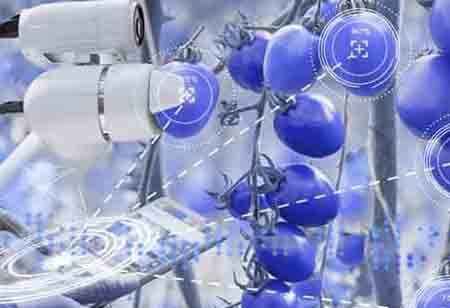Thank you for Subscribing to Agri Business Review Weekly Brief
What Digitisation Entails for Agriculture
The use of technology is one of the essential components that constitute digital in agriculture.

By
Agri Business Review | Tuesday, April 18, 2023
Stay ahead of the industry with exclusive feature stories on the top companies, expert insights and the latest news delivered straight to your inbox. Subscribe today.
Digital technologies such as smartphone apps, artificial intelligence, robotics, sensors, nanotechnology, gene editing technology, blockchain and data analytics are already at a niche stage in the current agricultural and food system and are expected to be implemented at full scale in the future.
FREMONT, CA: In the current agriculture and food system, digital technologies, including smartphone apps, artificial intelligence, robotics, sensors, nanotechnology, gene editing technology, blockchain, and data analytics, are already at a niche level, likely to be fully incorporated into the future.
The use of these technologies in agriculture is known as Agriculture 4.0 and international organisations like the World Bank, FAO, and OECD are highlighting the potential of digital technologies in resolving the issues with food and nutrition security. However, because of the possible unfavourable social, moral, and environmental effects of digital technology, their place in agriculture is still up for debate.
The use of technology is one of the essential components that constitute digital in agriculture. Agritech, as it is more popularly known, is the umbrella term for the use of contemporary technologies and the internet to reimagine agriculture as a global activity. Due to their ability to access and analyze previously unheard-of volumes of agri-big data, large and medium-sized businesses now can add value to the activities they oversee.
• Farm-level data: Data collected from a variety of sources, including mobile apps, sensors, drones, farm equipment, robotic devices, and other IoT devices, can be used to collect crucial farm data round-the-clock. Crop producers may monitor crop development in real-time, evaluate the performance of the farm plots, and reasonably predict the production for each farm plot using this data when combined with satellite and weather-based information.
• Precision agriculture: With precision agriculture, artificial intelligence can improve farm operations in numerous ways. It enables farmers to transform unprocessed agricultural data into useful insights that boost the yield and quality of their crops. Additionally, AI is enabling farmers to employ agricultural automation to save resources and select the best crops and crop kinds for their location.
• The digitalisation of the entire process: The agroecosystem's players are communicating more effectively thanks to the digitalisation of the entire process, from production and harvest through warehousing and distribution. The digitalisation of the supply chain has improved visibility for all parties along the way as well as efficiency.
Food producers now have access to a vast array of farm automation tools and data management solutions that enable them to increase resource and agricultural output thanks to the arrival of Agriculture 4.0. Farms that have embraced technological advancements have shown a clear transition away from the usage of antiquated, time-consuming procedures toward modernised, cost-effective operations. Additionally, by assuring more resilient and sustainable agri-food systems globally, management can use digital agriculture to connect organisational strategies with Sustainable Development Goals.
Understanding agricultural science and enhancing agronomic techniques to provide better results are key components of digital farming. Scalable and affordable solutions also make it easier for large and medium-sized businesses to disseminate a tried-and-true set of techniques to farmers, especially in developing regions, to encourage them to embrace more scientific farming practices. Agri-technology utilisation boosts farm output and aids in lowering crop losses brought on by pests, illnesses, and unpredictably harmful weather. Farmers can consequently make more money after each season. ICT solutions also help producers achieve the quality requirements imposed by international certifying authorities, increasing the likelihood that farmers will be paid more for their produce.
Digital solutions facilitate the virtual integration of numerous stakeholders, giving producers more direct access to, among other things, financial services, commodity dealers, and agri and agricultural inputs. This specifically aids smallholder farmers in overcoming some of their difficulties, such as a lack of knowledge about current commodity pricing and other crucial market information, a deficiency of skills to bargain for payment, and a lack of access to other purchasers in the market.
Digital solutions facilitate the virtual integration of numerous stakeholders, giving producers more direct access to, among other things, financial services, commodity dealers, and agri and agricultural inputs. This specifically aids smallholder farmers in overcoming some of their difficulties, such as a lack of knowledge about current commodity pricing and other crucial market information, a lack of skills to bargain for payment, and a lack of access to other purchasers in the market.
The provision of accurate near-real-time data to users by a digital agriculture system is yet another outstanding advantage. A combination of farm and satellite imaging-based knowledge offers useful insights on productivity depending on a variety of growth circumstances, enabling farmers to better plan their operations and manage their resources. The knowledge farmers receive throughout the supply chain also helps them understand market demands and adjust crop production as necessary. These insights can be used by both private businesses and governmental organisations to reduce risks, enhance agricultural management, and guarantee less crop loss and food waste.
Digital agriculture is promoting broad-spectrum development in the industry like never before, from updating how farming is done, and improving value for all ecosystem players, to bringing wholesome food to people worldwide. With current technology, producers can control supply and demand and embrace the best practices for a sustainable future. The worldwide R&D teams are also empowered by the accessibility of extensive data from various levels of food production and distribution to improve operational effectiveness both on and off the field and to create agri-inputs that can overcome current obstacles.





